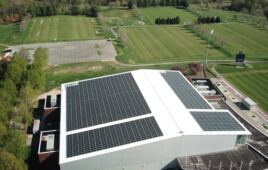 Clean energy was on the midterm ballot in a couple of states; either directly, with two states deciding whether to raise their Renewable Portfolio Standards; or indirectly with decisions on carbon prices and electricity market deregulation.
Clean energy was on the midterm ballot in a couple of states; either directly, with two states deciding whether to raise their Renewable Portfolio Standards; or indirectly with decisions on carbon prices and electricity market deregulation.
SEIA president and CEO Abigail Ross Hopper said this election showed that “voters and elected officials of both parties recognize the tremendous benefits that solar brings to our economy, environment and the reliability of the grid.”
Here’s what voters decided yesterday.
Nevada Question 6: PASSED
Vote Solar worked hard on the ground to pass this Nevada initiative that raises the state’s RPS to 50% by 2030. The Union of Concerned Scientists asked voters to pass Question 6 to reduce the threat of climate change. The state’s largest utility, NV Energy, stayed neutral on the question, and it faced little organized opposition, according to the Reno Gazette Journal. The group Clean Energy Works for Nevada said voters will have to pass the initiative again in 2020 in order for it to become law.
“Clean energy is putting Nevadans to work, with more than 25,000 strong employed in 2017. By increasing the state’s renewable standard, Nevada has set itself up to continue reaping the economic benefits for years to come,” said Ray Fakhoury, state policy manager with the Advanced Energy Economy, a national group of businesses that seek to reduce market barriers to advanced energy investments, in a statement. “Investing in clean energy resources helps diversify the state’s energy mix, protecting consumers from future energy price volatility.”
SEIA president and CEO Abigail Ross Hopper said in a statement, “Nevada voters made history last night, taking a vital step that puts the state on track to rapidly expand solar installations and create thousands of new jobs.”
The previous RPS in place was 25% renewables by 2025. This initiative defines renewable energy as solar, geothermal, wind, biomass and hydroelectric.
Nevada Question 3: FAILED
The other clean energy initiative on the ballot in Nevada—which was much more contentious—was Question 3. This initiative aimed to deregulate electricity markets in the state, which would have prevented NV Energy from establishing monopolies in its service areas, according to KUNR. Democrats said this bill would be harmful to clean energy procurement in the state and that it would undermine Question 6 and prevent future efforts for the state to go 100% renewable. Clean energy advocates came out against this bill, saying “a deregulated market would interrupt NV Energy’s commitment to double its current level of renewable energy generation by 2023, call into question the future of utility-sponsored energy efficiency programs, and introduce uncertainty into the state’s recovering rooftop solar industry.”
Casino mogul Sheldon Adelson became Question 3’s primary financial backer after state regulators prevented his casino from leaving NV Energy’s power grid without paying a $24 million fine, according to the Reno Gazette Journal. NV Energy, backed by billionaire Warren Buffett, who’s a chairman of NV Energy’s parent company, spent $63 million on opposition to Question 3.
Arizona Proposition 127: FAILED
The Arizona proposal to raise its RPS the same amount as Nevada—to 50% by 2030—faced fierce opposition from the state’s largest utility, Arizona Public Service (APS), along with a broad coalition of mostly conservative politicians across the state and other groups, according to The Arizona Republic. On the offense was the group Clean Energy for a Healthy Arizona, funded by billionaire activist Tom Steyer. The battle over this ballot measure was the most expensive in Arizona’s history, at about $40 million in spending as of Oct. 16, according to the Republic.
APS officials claimed the constitutional amendment would force them to shutter coal and nuclear plants ahead of schedule and would result in customer utility bills doubling. Other opponents did not like the idea of instituting the RPS by changing the constitution—which wouldn’t give utility regulators much flexibility on how they implement the plan.
Supporters of the amendment thought Arizona should follow other Western states where prices of solar and wind energy have fallen lower than traditional fossil-fuel plants. They also pointed to the draw of corporate solar procurement, saying Arizona needs more renewables to attract forward-thinking companies like Google and Apple.
Arizona’s RPS will remain at 15% by 2025 for now—a target that has already been met. In a statement, APS chairman Don Brandt said, “The campaign is over, but we want to continue the conversation with Arizonans about clean energy and identify specific opportunities for APS to build energy infrastructure that will position Arizona for the future.”
Washington Initiative 1631: FAILED
Evergreen State voters rejected a ballot initiative to put a carbon tax on fossil fuels for the second time. If passed, the initiative would have been the first carbon fee in the nation.
The carbon fee would have started at $25 per ton in 2020 and risen $2 each year (plus inflation) until 2035, according to Vox. The carbon revenue would have been invested back into the state to help offset carbon effects: 70% to “clean air and energy,” including easing the burdens of low-income energy consumers; 25% to “clean water and healthy forests” to increase environmental resiliency to climate change; and the remaining 5% to “healthy communities,” helping communities that are impacted by climate change.
Supporters of the bill from the Nature Conservancy said the battle to impose fees on fossil fuel emissions doesn’t end here. They’re looking ahead to getting a similar bill passed in Olympia next year, according to the Seattle Times.




Tell Us What You Think!